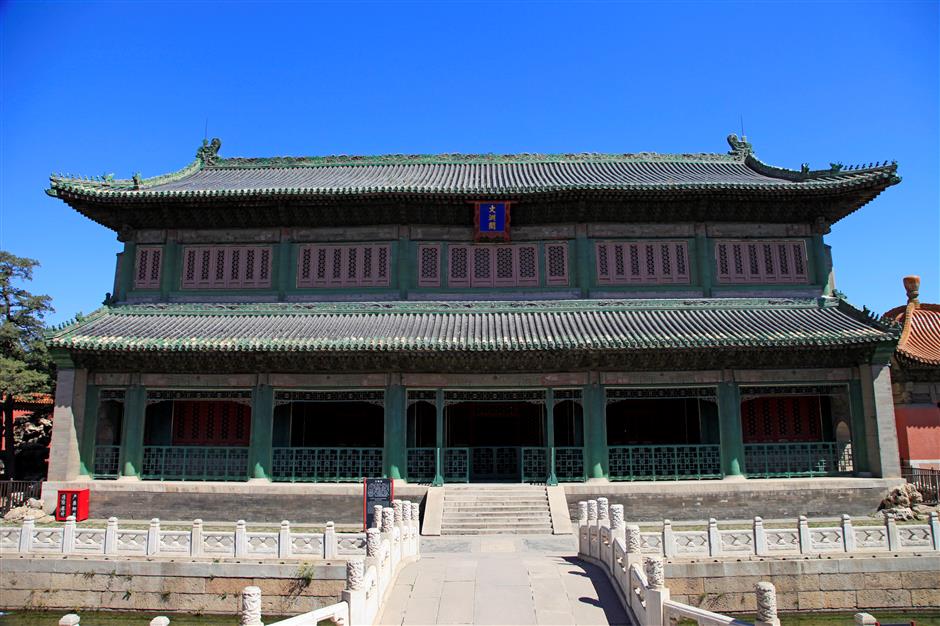Ancient library rises from ashes to house collection of classics

Wenyuan Pavilion, originally built in the Ming Dynasty (1368-1644), was rebuilt by Emperor Qianlong (1711-99) during the Qing Dynasty (1644-1911) to specifically store the “Siku Quanshu” (“Complete Works of Chinese Classics”).
For centuries ancient Chinese libraries were usually located by a pond in case of a fire emergency, and royal libraries strictly followed this tradition.
Wenyuan Pavilion, the biggest library inside the Forbidden City, was set up by a pond for that purpose. Unfortunately, the library didn’t escape its fate, despite being named “yuan” (deep water).
Wenyuan Pavilion, originally built in the Ming Dynasty (1368-1644), was rased to the ground in the farmers’ uprisings. The construction we see in its place today was rebuilt by Emperor Qianlong (1711-99) during the Qing Dynasty (1644-1911) to specifically store the “Siku Quanshu” (“Complete Works of Chinese Classics”), the largest collection of books in Chinese history.
First-time library visitors will be confused why its exterior posts and windows are painted green with black glazed tiles, which seems so obtrusive among red-wall-and-yellow-roof buildings inside the Forbidden City.
In traditional Chinese feng shui, or geomantic arrangement, the whole world is made up of five elements in different forms and combination: metal, wood, water, fire and soil. The color black stands for the “water” — element which overcomes fire. According to feng shui, the direction east is categorized under the element “wood” with its symbolic color green, meaning growth and hope. Thus, the exterior of the construction was mainly painted in green.
The rebuilt Qing Dynasty Wenyuan Pavilion copied the design of the Tianyi Pavilion in Ningbo, Zhejiang Province, the largest private library at the time, which was home to more than 70,000 precious books.
The library, at the back of the Wenhua Hall in the east of the Forbidden City, used to be the office of the crown prince.
Emperor Qianlong, who had a special residential complex in the Jiangnan area (regions south of the lower reaches of the Yangtze River), set up his own library at home following the style of the Tianyi Pavilion he visited during one of his six trips to the south.
The imperial library is probably the only building in the royal Forbidden City that is humble in design in comparison to the more majestic buildings situated there.
According to regal architectural rules, the rooms in each hall should be arranged in odd numbers, but the library has six rooms on each floor.
Its exterior walls are painted gray, not red, while its interior murals are scholars’ anecdotes instead of dragons and phoenix.
Among the resplendent, magnificent buildings, Wenyuan Pavillion is humble, quiet and seclusive.
The brick-and-wood pavilion faces the south and overlooks a square pond in the front square. The two-story building actually has a hidden floor in the middle to make full use of the space. Why this hidden floor was designed is a bit of a mystery.
The “Imperial Encyclopedia,” “The Catalogue of Siku Quanshu” and 20 shelves of classic texts, such as the Confucian Classics, were stored in the central three rooms on the first floor. The middle hidden floor was the warehouse for 33 shelves of history and geography books of the “Siku Quanshu,” while its 22 shelves of philosophy, arts and sciences, and 28 shelves of anthologies from Chinese literature were kept in the central three rooms on the second floor. The two rooms in the west and east didn’t store any books because they attracted dampness.
All books were placed in boxes made of mothproof nanmu wood on bookshelves in different sizes, which could be moved around to create a different space. At the center of the rooms, on both floors, there is a reading room for the emperor, equipped with a small bed, two pillows and a spittoon.
The pavilion was the only library for the emperor’s exclusive use, although he would invite ministers from time to time to talk about classics and literature. Very few people could get a permit to read in the library. This privilege was only reserved for the emperor’s favorite officials
As a matter of fact, there are six other similar Wenyuan Pavilions across China, each storing a copy of the “Complete Works of Chinese Classics.” Many of them were ruined in wars but fortunately copies were made and are held in China’s public library system.
















